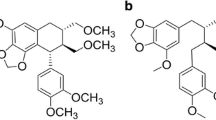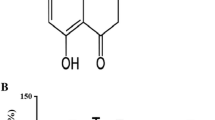Summary
Chrysoeriol is a flavonoid with antioxidant and anti-inflammatory activities. Despite the large number of studies performed on its biological activities, no clear picture of its mode of action has emerged. In the present study, we isolated chrysoeriol from the leaves of Digitalis purpurea (foxglove), and studied its effect on the induction of the inducible nitric oxide synthase (iNOS) gene, and the mechanism of this induction in Raw264.7 macrophages. Chrysoeriol pretreatment potently inhibited the release of NO in the cells treated with lipopolysaccharide (LPS), and Western blot and RT-PCR analyses revealed that chrysoeriol inhibited the LPS-induced inductions of iNOS gene. Moreover, it is known that the activations of nuclear factor-κB (NF-κB) and activator protein 1 (AP-1) are crucial steps in the transcriptional activation of the iNOS gene. Here, we found that chrysoeriol selectively suppressed AP-1 activation, and that activation of AP-1 is likely to be essential for iNOS induction in LPS-treated macrophages. This presumed inhibitory effect on AP-1 activation by chrysoeriol may be associated with its potent NO blocking and anti-inflammatory effects.
Similar content being viewed by others
Abbreviations
- AP-1:
-
activator protein-1
- DMEM:
-
Dulbecco’s modified Eagle’s medium
- ERK:
-
Extracellular signal-regulated kinase
- FCS:
-
fetal calf serum
- iNOS:
-
inducible nitric oxide synthase
- JNK:
-
c-Jun N-terminal kinase
- LPS:
-
lipopolysaccharide
- NF-κB:
-
nuclear Factor-κB
- NO:
-
nitric oxide
- S16r:
-
S16 ribosomal protein
- SDS:
-
sodium dodecyl sulfate
References
Lopez-Lazaro M, Palma De La Pena N, Pastor N, Martin-Cordero C, Navarro E, Cortes F, Ayuso MJ, Toro MV (2003). Anti-tumour activity of Digitalis purpurea L. subsp. heywoodii. Planta Med 69:701-704
Jang DS, Park EJ, Kang YH, Hawthorne ME, Vigo JS, Graham JG, Cabieses F, Fong HH, Mehta RG, Pezzuto JM, Kinghorn AD (2003). Potential cncer chemopreventive flavonoids from the stems of Tephrosia toxicaria. J Nat Prod 66:1166–1170
Liu YL, Ho DK, Cassady JM, Cook VM, Baird WM. (1992). Isolation of potential cancer chemopreventive agents from Eriodictyon californicum. J Nat Prod 55:357–363
Kim JH, Cho YH, Park SM, Lee KE, Lee JJ, Lee BC, Pyo HB, Song KS, Park HD, Yun YP (2004). Antioxidants and inhibitor of matrix metalloproteinase-1 expression from leaves of Zostera marina L. Arch Pharm Res 27:177–183
Abu Zarga M, Qauasmeh R, Sabri S, Munsoor M, Abdalla S (1995). Chemical constituents of Artemisia arborescens and the effect of the aqueous extract on rat isolated smooth muscle. Planta Med 61:242–245
Han LK, Sumiyoshi M, Zheng YN, Okuda H, Kimura Y (2003). Anti-obesity action of Salix matsudana leaves (Part 2). Isolation of anti-obesity effectors from polyphenol fractions of Salix matsudana. Phytother Res 17:1195–1198
Sadhu SK, Okuyama E, Fujimoto H, Ishibashi M (2003). Separation of Leucas aspera, a medicinal plant of Bangladesh, guided by prostaglandin inhibitory and antioxidant activities. Chem Pharm Bull (Tokyo) 51:595–598
Schinella GR, Giner RM, Recio MC, Mordujovich de Buschiazzo P, Rios JL, Manez S (1998). Anti-inflammatory effects of South American Tanacetum vulgare. J Pharm Pharmacol 50:1069–1074
Skaltsa H, Bermejo P, Lazari D, Silvan AM, Skaltsounis AL, Sanz A, Abad MJ (2000). Inhibition of prostaglandin E2 and leukotriene C4 in mouse peritoneal macrophages and thromboxane B2 production in human platelets by flavonoids from Stachys chrysantha and Stachys candida. Biol Pharm Bull 23:47–53
Kubes P, McCafferty DM (2000). Nitric oxide and intestinal inflammation. Am J Med 109:150–158
Szabo C, Southan GJ, Thiemermann C (1994). Beneficial effects and improved survival in rodent models of septic shock with S-methylisothiourea sulfate, a potent and selective inhibitor of inducible nitric oxide synthase. Proc Natl Acad Sci USA 91:12472–12476
Kim ND, Kang KW, Kim SG, Schini-Kerth VB (1997). Inhibition of inducible nitric oxide synthase expression and stimulation of the endothelial formation of nitric oxide most likely accounts for the protective effect of 2-(allylthio)pyrazine in a murine model of endotoxemia. Biochem Biophys Res Commun 239:310–315
Kang KW, Choi SY, Cho MK, Lee CH, Kim SG (2003). Thrombin induces nitric-oxide synthase via Galpha12/13-coupled protein kinase C-dependent I-kappaBalpha phosphorylation and JNK-mediated I-kappaBalpha degradation. J Biol Chem 278:17368–17378
Kang KW, Ryu JH, Kim SG (2000). The essential role of phosphatidylinositol 3-kinase and of p38 mitogen-activated protein kinase activation in the antioxidant response element-mediated rGSTA2 induction by decreased glutathione in H4IIE hepatoma cells. Mol Pharmacol 58:1017–1025
Cho MK, Suh SH, Kim SG (2002). JunB/AP-1 and NF-kappa B-mediated induction of nitric oxide synthase by bovine type I collagen in serum-stimulated murine macrophages. Nitric Oxide 6:319–332
Xie QW, Whisnant R, Nathan C (1993). Promoter of the mouse gene encoding calcium-independent nitric oxide synthase confers inducibility by interferon-γ and bacterial lipopolysaccharide. J Exp Med 177:1779–1784
Park OJ, Surh YJ (2004). Chemopreventive potential of epigallocatechin gallate and genistein: evidence from epidemiological and laboratory studies. Toxicol Lett 150:43–56
Williams CA, Grayer RJ (2004). Anthocyanins and other flavonoids. Nat Prod Rep 21:539–573
Chen Y, Yang L, Lee TJ (2000). Oroxylin A inhibition of lipopolysaccharide-induced iNOS and COX-2 gene expression via suppression of nuclear factor-kappaB activation. Biochem Pharmacol 59:1445–1457
Olszanecki R, Gebska A, Kozlovski VI, Gryglewski RJ (2002) Flavonoids and nitric oxide synthase. J Physiol Pharmacol 53:571–584
Laskin DL, Pendino KJ (1995). Macrophages and inflammatory mediators in tissue injury. Annu Rev Pharmacol Toxicol 35:655–677
Southan GJ, Szabo C (1996). Selective pharmacological inhibition of distinct nitric oxide synthase isoforms. Biochem Pharmacol 51:383–394
Cieslik K, Zhu Y, Wu KK (2002). Salicylate suppresses macrophage nitric-oxide synthase-2 and cyclo-oxygenase-2 expression by inhibiting CCAAT/enhancer-binding protein-beta binding via a common signaling pathway. J Biol Chem 277:49304–49310
Lee AK, Sung SH, Kim YC, Kim SG (2003). Inhibition of lipopolysaccharide-inducible nitric oxide synthase, TNF-alpha and COX-2 expression by sauchinone effects on I-kappaBalpha phosphorylation, C/EBP and AP-1 activation. Br J Pharmacol 139:11–20
Matrone C, Pignataro G, Molinaro P, Irace C, Scorziello A, Di Renzo GF, Annunziato L (2004). HIF-1alpha reveals a binding activity to the promoter of iNOS gene after permanent middle cerebral artery occlusion. J Neurochem 90:368–378
Burstein E, Duckett CS (2003). Dying for NF-kappaB? Control of cell death by transcriptional regulation of the apoptotic machinery. Curr Opin Cell Biol 15:732–737
Denk A, Wirth T, Baumann B (2000). NF-kappaB transcription factors: critical regulators of hematopoiesis and neuronal survival. Cytokine Growth Factor Rev 11:303–320
Pizzi M, Goffi F, Boroni F, Benarese M, Perkins SE, Liou HC, Spano P (2002). Opposing roles for NF-κB/Rel factors p65 and c-Rel in the modulation of neuron survival elicited by glutamate and interleukin-1β. J Biol Chem 277:20717–20723
Yu Z, Zhou D, Cheng G, Mattson MP (2000). Neuroprotective role for the p50 subunit of NF-κB in an experimental model of Huntington’s disease. J Mol Neurosci 15:31–44
Gilmore TD (1999). The Rel/NF-kappaB signal transduction pathway: introduction. Oncogene 18:6842–6844
De Bosscher K, Vanden Berghe W, Haegeman G (2003). The interplay between the glucocorticoid receptor and nuclear factor-kappaB or activator protein-1: molecular mechanisms for gene repression. Endocr Rev 24:488–522
Shaulian E, Karin M (2001). AP-1 in cell proliferation and survival. Oncogene 20:2390–2400
Lowenstein CJ, Alley EW, Raval P, Snowman AM, Snyder SH, Russell SW, Murphy WJ (1993). Macrophage nitric oxide synthase gene: two upstream regions induction by interferon gamma and lipopolysaccharide. Proc Natl Acad Sci USA 90:9730–9734
Pham CG, Bubici C, Zazzeroni F, Papa S, Jones J, Alvarez K, Jayawardena S, De Smaele E, Cong R, Beaumont C, Torti FM, Torti SV, Franzoso G (2004). Ferritin heavy chain upregulation by NF-kappaB inhibits TNFalpha-induced apoptosis by suppressing reactive oxygen species. Cell 119:529–542
Springer J, Pleimes D, Scholz FR, Fischer A (2005). Substance P mediates AP-1 induction in A549 cells via reactive oxygen species. Regul Pept 124:99–103
Woo CH, Lim JH, Kim JH (2004). Lipopolysaccharide induces matrix metalloproteinase-9 expression via a mitochondrial reactive oxygen species-p38 kinase-activator protein-1 pathway in Raw 264.7 cells. J Immunol 173:6973–6980
Lin SJ, Shyue SK, Liu PL, Chen YH, Ku HH, Chen JW, Tam KB, Chen YL (2004). Adenovirus-mediated overexpression of catalase attenuates oxLDL-induced apoptosis in human aortic endothelial cells via AP-1 and C-Jun N-terminal kinase/extracellular signal-regulated kinase mitogen-activated protein kinase pathways. J Mol Cell Cardiol 36:129–139
Mishra B, Priyadarsini KI, Kumar MS, Unnikrishnan MK, Mohan H (2003). Effect of O-glycosilation on the antioxidant activity and free radical reactions of a plant flavonoid, chrysoeriol. Bioorg Med Chem 11:2677–2685
Acknowledgements
This work was supported in part by a grant from the Regional University Research Program (E-00216; Kang K.W.) funded by Korea Research Foundation and the Plant Diversity Research Center 21st Century Frontier Research Program funded by the Korean Ministry of Science and Technology (Grant No. PF0320505-00; Woo E.).
Author information
Authors and Affiliations
Corresponding author
Additional information
First two authors equally contributed to this work.
Rights and permissions
About this article
Cite this article
Choi, DY., Lee, J.Y., Kim, MR. et al. Chrysoeriol potently inhibits the induction of nitric oxide synthase by blocking AP-1 activation. J Biomed Sci 12, 949–959 (2005). https://doi.org/10.1007/s11373-005-9028-8
Received:
Accepted:
Published:
Issue Date:
DOI: https://doi.org/10.1007/s11373-005-9028-8




